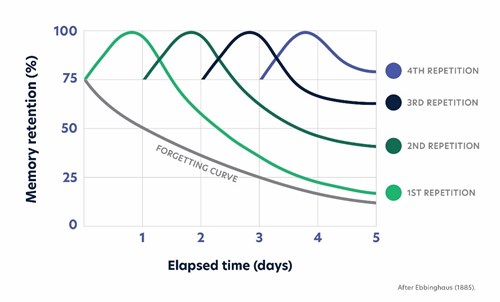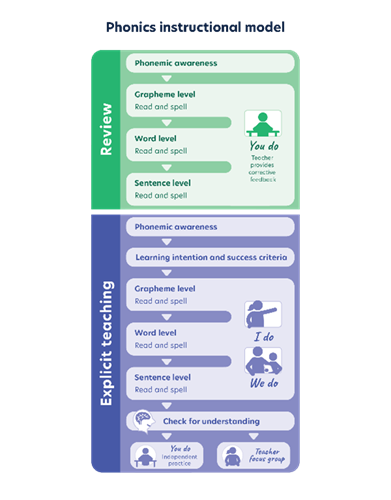Explicit instruction for phonics – an instructional model
If you have chosen a systematic synthetic phonics (SSP) progression but are wondering how to begin instruction, this topic will help you understand and implement the elements of explicit instruction. This topic covers:
- the principles of explicit instruction
- a phonics instructional model for reading and spelling, with practical guidance for implementation.
Learning objectives
By the end of this topic, you will:
- understand the principles of explicit instruction and be able to plan and run phonics lessons following explicit instruction principles
- be able to follow the Literacy Hub phonics instructional model for reading and spelling, which is aligned with explicit instruction
- know how to plan and run daily reviews of taught phonics content.
Download resources for this topic or view Australian Curriculum links.

A note about terminology
There are many different terms used in academic literature to describe the teaching approach covered in this topic. In this professional learning we use the generic term 'explicit instruction'. This broad term is distinct from Explicit Direct Instruction (EDI), a specific teaching approach developed by Ybarra and Hollingsworth; and Direct Instruction (DI), a suite of commercial programs developed by Engelmann, Becker and associates.
1. Spotlight on explicit instruction for phonics – an instructional model
40 minutes reading and viewing
Rosenshine (1987) describes explicit instruction as ‘a systematic method of teaching with emphasis on proceeding in small steps, checking for student understanding, and achieving active and successful participation by all students’.
This 2-minute read briefly outlines what explicit instruction is and the evidence for using it.
The Literacy Hub has developed a phonics instructional model that follows explicit instruction principles when teaching phonics. The diagram below (from the model) depicts the routine of a standard phonics lesson.
What are the principles of explicit instruction?
The following principles summarise explicit instruction.
Teacher-directed: The teacher is the expert and directs students’ attention, guiding them through the process required for building new learning.
Clear learning objectives: Students are given clear learning objectives at the beginning of each lesson to focus attention and effort.
'I do', 'We do', then 'You do': The gradual release of responsibility framework is used to support students as they learn new content. The teacher starts by modelling a new skill explicitly ('I do') before scaffolding students through guided practice ('We do') to apply the skill. Students are only given independent tasks ('You do') once they have shown the ability to apply the new skill with reduced support.
Spaced reviews: The teacher supports students to retrieve previously taught content, reducing prompts as student knowledge and skills develop over time.
Small chunks of new content: The teacher addresses small, targeted pieces of new content or specific new skills in each lesson.
Highly interactive: Students actively participate in the lesson, maintaining engagement and attentiveness throughout.
Routines-based: Routines, expectations and pace of each lesson remain constant and familiar to students to reduce cognitive load.
Constant monitoring and feedback: Lesson design incorporates checks for student understanding and opportunities for immediate feedback. This keeps the learning on track and allows teachers to evaluate the effectiveness of their instruction.
This 4-minute read outlines how to check for understanding.
This 7-minute read is a short explicit instruction practice guide.
Why follow an instructional model?
Following an instructional model allows all the principles of explicit instruction to be built into lesson plans and lesson delivery. It provides consistency across lessons and classes so that students become familiar with the routines, expectations and the pace of each lesson, enabling teachers to maximise the effectiveness of Tier 1, whole-class instruction.
In addition, following an explicit instruction model reduces cognitive load, allowing students to focus on new learning instead of on lesson structure and task format.
Dr Stanislas Dehaene, a leading cognitive neuroscientist, supports the need for an instructional model to support the four pillars of learning: attention, active engagement, feedback and consolidation.
Read this 9-minute article about harnessing the four pillars of learning in phonics.
Why include a daily review?
Structured daily reviews give students practice at retrieving previously taught information from long-term memory. The more they practise, the more automatic this retrieval process becomes, resulting in decoding and encoding fluency. With these skills mastered, students have more cognitive resources to focus on further literacy skills such as reading comprehension and writers’ craft.
The forgetting curve from Ebbinghaus (1885) shows how repetition of retrieval over time improves memory retention. Reviews are most effective when they support active retrieval, that is, when students are given the minimal amount of prompting needed.

Read this 2-minute overview of daily reviews, with videos to illustrate daily reviews in action.
This daily review example slide pack follows explicit instruction principles. It can be used in Foundation to Year 2 classrooms, and can be updated to match any phonics progression.
What content and skills should be included in a phonics lesson for beginners?
When students are first learning to read and spell, a lesson should include modelling and guided practice in the following areas:
- oral blending and segmenting skills for consonant-vowel-consonant (CVC) pattern words
- early letter–sound correspondences
- correct formation of taught graphemes (letters)
- identifying the target phoneme (sound) at the beginning of a spoken word.
Importantly, students should be building knowledge of the relationship between the written grapheme and the matching phoneme. It is also useful for students to learn the names of letters; these should therefore also be referenced within phonics lessons, for example, 's' says /s/ when writing the letter 's'.
These sample explicit instruction phonics lesson slides, with an accompanying student worksheet, outline a lesson for beginner readers.
What content and skills should be included in a standard phonics lesson?
As students make progress, teachers can introduce word-level reading and spelling and then sentence-level reading and writing. Teachers should continue to include phonemic awareness instruction as needed and should consistently include a daily review and an explicit teaching section.
In the explicit teaching section of the lesson, teacher modelling and guided practice should be provided for both reading and spelling of:
- letter–sound correspondences
- words with target letter–sound correspondences
- irregular words
- sentences with target letter–sound correspondences.
Next, the teacher checks for understanding so that students can be directed to independent practice or included in a teacher-led focus group.
This 3-minute video shows explicit instruction in a classroom.
This 7-minute read summarises recent research relating to word-level reading and irregular words.
These sample explicit instruction phonics lesson slides, with an accompanying student worksheet, outline a lesson for students who have progressed beyond beginner level.
Download a slide pack for reviewing irregular words and pair-game templates for independent practice.
This 4-minute video shows two teachers discussing why and how to teach irregular words.
2. Videos: Explicit instruction for phonics – an instructional model
|
Watch these videos from Literacy Hub webinars on explicit instruction and using instructional models in the classroom, including:
|
 |
These videos unpack each of the Literacy Hub’s explicit instruction and instructional model resources.
3. Putting learning into action
Now that you have engaged with this topic, use the prompts below as an opportunity to reflect on your current practice and take action in response to your new learning.
Actions for Foundation to Year 2 school leaders
You may wish to:
1. Lead your staff through the 'Spotlight on explicit instruction for phonics – an instructional model' section and included links.
2. Discuss the following questions with your staff (reflecting and evaluating):
- What do our current phonics lessons look like? Do they support both reading and spelling?
- What do we do now that aligns with explicit instruction? What improvements could be made?
- Could the Literacy Hub instructional model work for our school?
3. Support your staff to explore the downloadable resources and use the explicit instruction slide pack to trial a phonics lesson.
4. Determine a phonics instructional model for your school.
Actions for Foundation to Year 2 teachers
1. Determine your starting point on the phonics progression.
2. Plan an explicit instruction phonics lesson, for beginners or for students who have started to progress.
3. Create and use a slide pack with your planned content.
4. Reflect on your students’ response to the model lesson and the new learning.
Resource downloads
This document outlines a practical explicit instructional model for phonics.
This example daily review slide pack is ready for classroom use. It can be edited to match any phonics lesson.
This slide pack is intended to help students review irregular words. It can be used alongside the daily review slide pack.
- Sample phonics lesson slides and worksheet (beginner)
This slide pack and accompanying worksheet gives a phonics lesson for students in the first weeks of literacy instruction.
- Sample phonics lesson slides and worksheet (standard)
This slide pack and accompanying worksheet gives a phonics lesson for students who are beyond the first weeks of literacy instruction.
These printable worksheets can be used during phonics lessons. Ideas for games and other activities are included.
References, useful links and further reading
- Association of Independent Schools of NSW (AISNSW). Principles of instruction – checking for understanding. Retrieved from https://www.aisnsw.edu.au/teachers-and-staff/teaching-and-learning/literacy-and-numeracy/foundations-of-effective-instruction/principles-of-instruction/checking-for-understanding
This webpage provides an overview of how to check for understanding in the classroom.
- Association of Independent Schools of NSW (AISNSW). Principles of instruction – daily review. Retrieved from https://www.aisnsw.edu.au/teachers-and-staff/teaching-and-learning/literacy-and-numeracy/foundations-of-effective-instruction/principles-of-instruction/daily-review
This webpage outlines the key components of a daily review. It includes a downloadable example.
- Australian Education Research Organisation (AERO). Explicit instruction practice guide – full publication. Retrieved from https://www.edresearch.edu.au/resources/explicit-instruction-practice-guide/explicit-instruction-practice-guide-full-publication
This webpage outlines evidence-based practices for implementing explicit instruction.
- Australian Education Research Organisation (AERO). Explicit instruction rubric. Retrieved from https://www.edresearch.edu.au/resources/explicit-instruction-rubric
This rubric outlines a set of capabilities to do with the evidence-based practice of explicit instruction.
- McLean, E. (2020, 24 June). Teaching word-level reading [blog post]. Retrieved from https://www.eminamclean.com/post/teaching-word-level-reading
This blog post discusses how to teach word-level reading.
- Rosenshine, B. (2012, Spring). Principles of instruction: research-based strategies that all teachers should know. American Educator. Retrieved from https://www.aft.org/periodical/american-educator/spring-2012/principles-instruction
This article presents 10 research-based principles of instruction from Barak Rosenshine, a key researcher in this field.
- Seamer, J. (2021, 20 June). Harnessing the 4 pillars in phonics instruction [blog post]. Retrieved from https://www.jocelynseamereducation.com/blog/56365-harnessing-the-4-pillars-in-phonics
This blog post explores the work of Stanislas Dehaene in relation to maximising the impact of teaching.
- Seamer, J. (2022, 4 September). Spaced practice and interleaving in the classroom [blog post]. Retrieved from https://www.jocelynseamereducation.com/blog/73183-spaced-practice-and-interleaving-in-the
This blog post discusses how to use spaced practice and interleaving in the reading classroom.
- Wheldall, K., Stephenson, J. & Carter, M. (2017, October). ‘What is direct instruction?’ Nomanis Notes, Issue 2. Retrieved from https://20821764.fs1.hubspotusercontent-na1.net/hubfs/20821764/Nomanis_June2023/Pdf/NomanisNotes_%232DirectInstruction.pdf
This one-page article provides a brief overview of direct instruction.
Australian Curriculum links
Australian Curriculum – English: Literacy – Phonic and word knowledge (scroll to Phonic and word knowledge section at the bottom of the page)
Australian Curriculum – General capabilities: Literacy – Writing – Spelling
